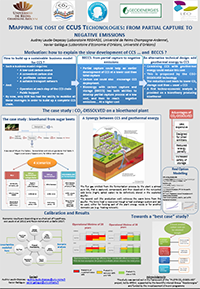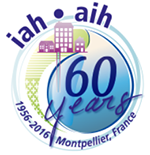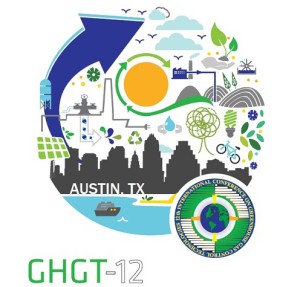2018 |
2017 |
2016 |
2015 |
2014 |
2018
Poster presented at the BECCS conference in Gothenburg, Sweden, May 22-24, 2018

With the future climate at stake, a deeper and fuller understanding of negative emissions is needed. The purpose of the conference was to bring together a wide range of scientists, experts and stakeholders, in order to engage in various aspects of research relating to negative CO2 emissions. Topics included various negative emission technologies, climate modelling, climate policies and incentives. The three-day event brought together around 250 researchers at Chalmers University of Technology to discuss the different ways to remove CO2 from the atmosphere and store it on land, underground or in the oceans.
Members of the CO2-DISSOLVED team, Xavier GALIEGUE and Audrey LAUDE from LEO (Orléans Economics Laboratory) presented their work carried out as part of the PILOTE CO2-DISSOLVED project in a poster
"MAPPING THE COST OF CCUS TECHONOLOGIES: FROM PARTIAL CAPTURE TO NEGATIVE EMISSIONS"
Poster
Abstract
There is a general agreement to consider that a growing gap is appearing between the different CCS roadmaps (IEA 2009, 2013) targets and the current deployment of CCS pilot units. The reasons of this gap have been documented in Herzog (2016), they are linked basically to the difficulty of finding a suitable business model for these emerging technologies. The aim of this paper is to address this question in considering three factors influencing the CCS costs. -It is straightforward to state that the cost of CCS technologies is rising with the capture rate, from low capture rate to full capture for CCS on fossil fuels, and from partial capture rate to negative emissions for CCS on bioenergy plants (BECCS). So a cost-minimizing CCS deployment strategy should take into account this characteristic, in combining rising capture rate on installed facilities with the deployment of costlier technologies. This is specifically the case of BECCS technologies, which can capture pure carbon at a low cost.
- Surveys of the operating actual CCS projects (CCS Institute, 2017; Herzog, 2017) show that by now most successful CCS projects have had the ability to link a low-cost carbon source (generally trough gas separation) with an easy and convenient sink (depleted oil field) and a valuable revenue source in EOR projects. So CCS deployment must depend on this ability to shift from low-cost carbon source and sink, which could be mobilized in a first step, to more costly technologies on each steps of the CCS process. In this field, the development of CCUS could appear as a convenient way to find viable use of carbon, despite the low potential capture level of that technologies (Mac Dowell, 2017). The paper will then propose a typology of CCUS technologies according to the cost conditions of capture and storage.
-Minimizing the energy penalty could be also done by using renewable energy on the whole capture and storage process, a process that could lead to negative emissions at a lower cost. Generally this source of energy is coming from geothermal sources, like in the CO2DISSOLVED process (Kervevan et al, 2017) or in competing technologies (Li et al, 2016). The availability of negative emissions is then linked to the combination of these three factors: sensibility of costs related to the carbon capture rate, ability to find convenient uses for carbon, low cost capture technologies and reservoirs, and to use renewable energy in the process. The paper will offer a typology of the different technologies according to these three criteria.
Conference review and coverage by Carbon Brief Negative emissions: Scientists meet in Sweden for first international conference
2017
 Oral presentation at the 12th CO2GeoNet Open Forum
Oral presentation at the 12th CO2GeoNet Open Forum
"CO2 -DISSOLVED: an innovative CCS approach fitted to small industrial emitters" presented by Christophe Kervévan of BRGM as part of the workshop "FIT-FOR-PURPOSE SOLUTIONS FOR CCS"
2016
GHGT-13, the International Conference on Greenhouse Gas Control Technologies, 14-18 November 2016, SwissTech Convention Center - Lausanne, Switzerland
CO2-DISSOLVED team participated as follows:
43rd IAH (International Association of Hydrogeologists) Congress, 25-29 September 2016, Montpellier, France
Oral presentation (Abstract no. 1921, session 5.03)
I. Czernichowski ; P. Audigane; M. Gastine ; C. Kervévan ; R. Stead. Storing CO2 in deep saline aquifers as part of integrated territorial energy and climate plans.
2015
ADEME "Bilan GES" workshop, 8 January 2015, Paris, France
Audrey LAUDE-DEPEZAY is assistant professor at the REGARDS laboratory of the University of Reims. She formely worked with Xavier GALIEGUE (LEO). In the CO2-DISSOLVED project, Audrey works as an economist, the REGARDS laboratory being subcontracted by the LEO.
In this scientific workshop on greenhouse gases organized by ADEME (French Agency on Environment and Energy), Audrey presented an abstract and a poster (in French) about the negative CO2 emissions concept and how the CO2-DISSOLVED approach could contribute.
The paper and the poster are co-authored by Audrey LAUDE-DEPEZAY and Jonathan ROYER-ADNOT (Geogreen).
Pre-COP21 event: International conference "Our common future under climate change" (CFCC), 7-10 July 2015, Paris, France
Xavier GALIÈGUE (LEO) presented a poster co-authored by Audrey LAUDE-DEPEZAY (REGARDS) "Negative emissions in sustainable transition: Which role for bioenergies and CCS?". This poster, focused on the economical aspects of the CO2-DISSOLVED concept when applied to a biofuel production context. The abstract can be consulted here
2014
GHGT-12, the International Conference on Greenhouse Gas Control Technologies, 5-9 October 2014, Austin Convention Center, Texas, USA
CO2-DISSOLVED team participated as follows:
Dernière mise à jour le 21.10.2019













